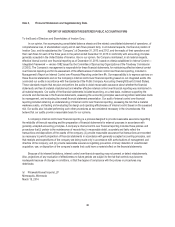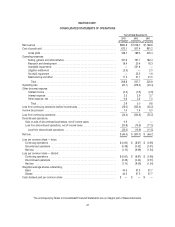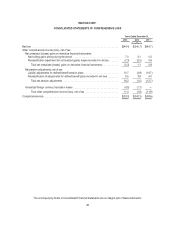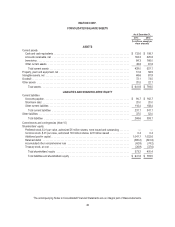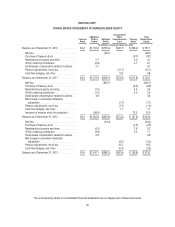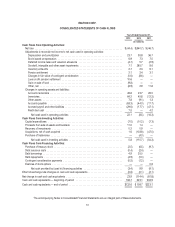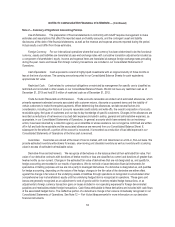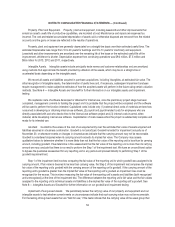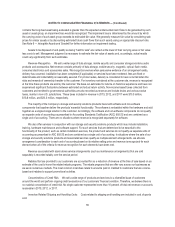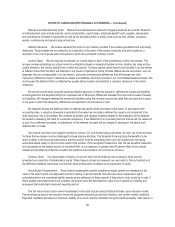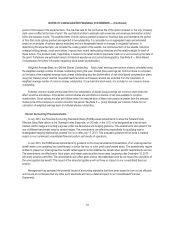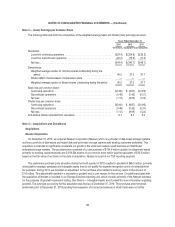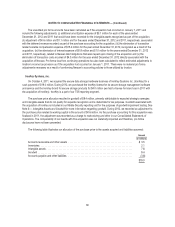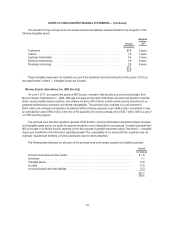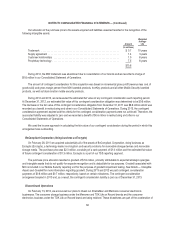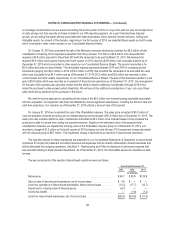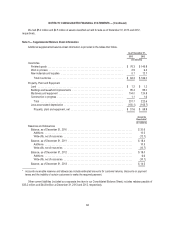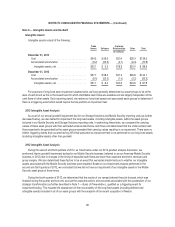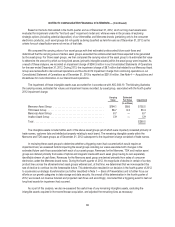Memorex 2013 Annual Report Download - page 59
Download and view the complete annual report
Please find page 59 of the 2013 Memorex annual report below. You can navigate through the pages in the report by either clicking on the pages listed below, or by using the keyword search tool below to find specific information within the annual report.NOTES TO CONSOLIDATED FINANCIAL STATEMENTS — (Continued)
Research and Development Costs. Research and development costs are charged to expense as incurred. Research
and development costs include salaries, stock compensation, payroll taxes, employee benefit costs, supplies, depreciation
and maintenance of research equipment as well as the allocable portion of facility costs such as rent, utilities, insurance,
repairs, maintenance and general support services.
Rebates Received. We receive rebates from some of our inventory vendors if we achieve pre-determined purchasing
thresholds. These rebates are accounted for as a reduction of the price of the vendor’s products and are included as a
reduction of our cost of goods sold in the period in which the purchased inventory is sold.
Income Taxes. We are required to estimate our income taxes in each of the jurisdictions in which we operate. This
process involves estimating our actual current tax obligations based on expected taxable income, statutory tax rates and tax
credits allowed in the various jurisdictions in which we operate. Tax laws require certain items to be included in our tax returns
at different times than the items are reflected in our results of operations. Some of these differences are permanent, such as
expenses that are not deductible in our tax returns, and some are temporary differences that will reverse over time.
Temporary differences result in deferred tax assets and liabilities, which are included in our Consolidated Balance Sheets. We
must assess the likelihood that our deferred tax assets will be realized and establish a valuation allowance to the extent
necessary.
We record income taxes using the asset and liability approach. Under this approach, deferred tax assets and liabilities
are recognized for the expected future tax consequences of temporary differences between the book and tax basis of assets
and liabilities. We measure deferred tax assets and liabilities using the enacted statutory tax rates that are expected to apply
in the years in which the temporary differences are expected to be recovered or paid.
We regularly assess the likelihood that our deferred tax assets will be recovered in the future. In accordance with
accounting rules, a valuation allowance is recorded to the extent we conclude a deferred tax asset is not considered to be
more-likely-than-not to be realized. We consider all positive and negative evidence related to the realization of the deferred
tax assets in assessing the need for a valuation allowance. If we determine it is more-likely-than-not that we will not realize all
or part of our deferred tax assets, an adjustment to the deferred tax asset will be charged to earnings in the period such
determination is made.
Our income tax returns are subject to review by various U.S. and foreign taxing authorities. As such, we record accruals
for items that we believe may be challenged by these taxing authorities. The threshold for recognizing the benefit of a tax
return position in the financial statements is that the position must be more-likely-than-not to be sustained by the taxing
authorities based solely on the technical merits of the position. If the recognition threshold is met, the tax benefit is measured
and recognized as the largest amount of tax benefit that, in our judgment, is greater than 50 percent likely to be realized.
Interest and penalties recorded for uncertain tax positions are included in our income tax provision.
Treasury Stock. Our repurchases of shares of common stock are recorded at cost as treasury stock and are
presented as a reduction of shareholders’ equity. When treasury shares are reissued, we use a last-in, first-out method and
the difference between repurchase cost and fair value at reissuance is treated as an adjustment to equity.
Stock-Based Compensation. Stock-based compensation awards classified as equity awards are measured at fair
value at the date of grant and expensed over their vesting or service periods. We also have stock appreciation rights
outstanding which are considered liability awards as the settlement of these awards, if they were to vest, would be in cash. If
these awards were determined to be probable, we would record the estimated fair value of such awards as a liability and
remeasure their estimated value each reporting period.
The fair value of each option award is estimated on the date of grant using the Black-Scholes option valuation model.
The assumptions used in the valuation model are supported primarily by historical indicators and current market conditions.
Expected volatilities are based on historical volatility of our stock and are calculated using the historical weekly close rate for a
56


